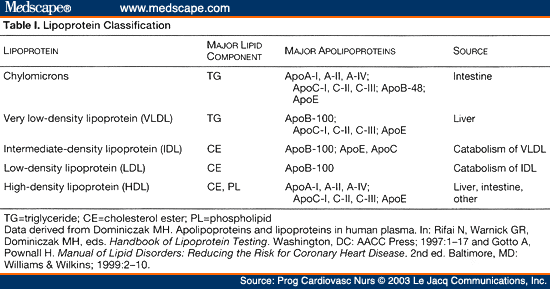Structure and Classification of Lipoproteins and Apolipoproteins
Although cholesterol and TG serve several important functions within the body, they are insoluble particles and must be packaged into lipoproteins in order to circulate in the plasma, from sites of synthesis or absorption to sites of use. The core of the lipoprotein, containing cholesterol ester and TG, is nonpolar and hydrophobic, and the outer layer of the lipoprotein particle (containing free cholesterol, phospholipid, and specific apolipoproteins), is polarized, permitting the lipoprotein particles to be transported in the circulation. Apolipoproteins (apo) such as apoB, apoC and apoE, coat lipoprotein particles and serve a number of functions including the transport of lipids in the blood and recognition of lipoprotein particles by enzymes which process or remove lipids from the lipoprotein particles. For example, apoC-II activates the enzyme lipoprotein lipase (LPL), which removes TG from lipoprotein particles such as chylomicrons and VLDL.
Each lipoprotein class (chylomicrons, VLDL, IDL, LDL, and HDL) varies in size, density, and lipid composition within the core of the particle. Within the main classes of lipoproteins, there may be further differentiation into subclasses, but for the purposes of this discussion they are referred to as a single lipoprotein. Chylomicrons and VLDL are the largest, most buoyant particles, having more TG within their core; in contrast, LDL and HDL have more cholesterol ester within their core and hence, greater particle density. Table I depicts the lipoprotein classification, including the major lipid component, apolipoproteins associated with each particle, and the source of the particle.
Chylomicrons are produced in the intestinal lumen following the absorption of digested fat. They are the largest lipoprotein and are rich in TG. Because of their particle size, chylomicrons scatter more light and may cause the serum to take on a cloudy appearance after meals, or in patients with dyslipidemic syndromes characterized by the inability to catabolize chylomicrons and TG rich lipoproteins. Chylomicrons are transported in the blood to tissues such as skeletal muscle, fat, and the liver. The capillary beds of these tissues contain high concentrations of LPL. LPL hydrolyzes TG in the chylomicrons into free-fatty acids that are either oxidized by the muscle cells to generate energy, stored in adipose tissue, oxidized in the liver, or used in hepatic VLDL synthesis.[8] Once the chylomicrons have been processed by LPL, the TG-depleted chylomicron is called a remnant particle, which is then transported to the liver for further processing.
VLDL is a lipoprotein particle similar to chylomicrons, which contains a high concentration of TG. VLDL is synthesized from free-fatty acids formed in the catabolism of chylomicrons in the liver, or from endogenous production of TG.[9] The TG component of VLDL also undergoes hydrolysis by capillary LPL to provide fatty acids to adipose and muscle tissue. The remaining lipid portion is called IDL. IDL is then converted to LDL by enzymatic action of hepatic lipase or is taken up by the liver via the LDL receptor.
LDL particles carry the majority of the cholesterol in the blood, supplying cholesterol to the cells. LDL receptors in peripheral cells or liver bind with LDL and clear it from the blood. Peripheral cells utilize LDL cholesterol for cell membrane structure and also the production of hormones. LDL is an atherogenic lipoprotein particle, and it is established that higher levels of LDL are associated with increased cardiovascular disease risk.[10] In addition, the heterogeneity of LDL particle composition, due to differences in the amount of cholesterol per particle, suggests that particle size is an important consideration in the atherogenic potential of the LDL. Although the exact mechanism is not fully appreciated, small, dense LDL particles containing more cholesterol ester (phenotype B) are considered to be more atherogenic than buoyant LDL (phenotype A) particles. Small, dense LDL is thought to be more susceptible to oxidative modification and may therefore be more toxic to the vascular endothelium. A sequence of immunologic and inflammatory events in the arterial wall contributes to atherogenesis and the development of atherosclerotic lesions. These advanced lesions occlude coronary artery blood flow and contribute to clinical presentations such as unstable angina or myocardial infarction.[11]
It is well established that increased HDL levels are associated with decreased risk for coronary heart disease, whereas reduced HDL levels increase risk. The cardioprotective role of HDL is to facilitate the transfer of cholesterol from atherogenic lipoproteins and peripheral tissues to the liver. Although suggestive of a simple "reverse transport" process, the exact mechanism, dependent on the interactions between HDL apolipoproteins and enzyme activity, is highly complex and poorly understood. HDL particles are synthesized and catabolized in the liver and intestines. Nascent HDL obtains free cholesterol from peripheral tissues. A circulating enzyme called lecithin:cholesterol acyltransferase promotes the uptake of free cholesterol by HDL by a reaction called esterification. The esterification of free cholesterol into cholesterol ester produces a more hydrophobic core, enhancing the density of the HDL particle. Another enzyme, cholesteryl ester transfer protein, mediates the transfer of cholesterol ester from the HDL core and other circulating lipoproteins such as LDL.[12]
Lipoprotein(a) [Lp(a)] is another lipoprotein particle which in structure is very similar to LDL with the addition of apolipoprotein(a). Lp(a) links lipid metabolism with blood coagulation,[13] and because of the structural similarities of the Lp(a) particle to both LDL and plasminogen, it is thought that this particle has both atherogenic and thrombogenic potential.[14] Lp(a) may inhibit thrombolysis and elevated levels are linked to increased risk for coronary heart disease[15]; this risk appears greater in the presence of elevated LDL cholesterol levels.[16]
Several apolipoproteins have been identified; Table I depicts the apolipoproteins associated with each class of lipoprotein. Apolipoproteins have many roles in lipid metabolism, which are presented in Table II .
Table III lists several major enzymes involved in lipoprotein metabolism that have been identified. Activated by the apolipoproteins, these enzymes serve a unique role, but not all are completely understood.
© 2003 Le Jacq Communications, Inc.
© 2007 Prog Cardiovasc Nurs
Cite this: Understanding the Essentials of Blood Lipid Metabolism - Medscape - Jan 01, 2003.





